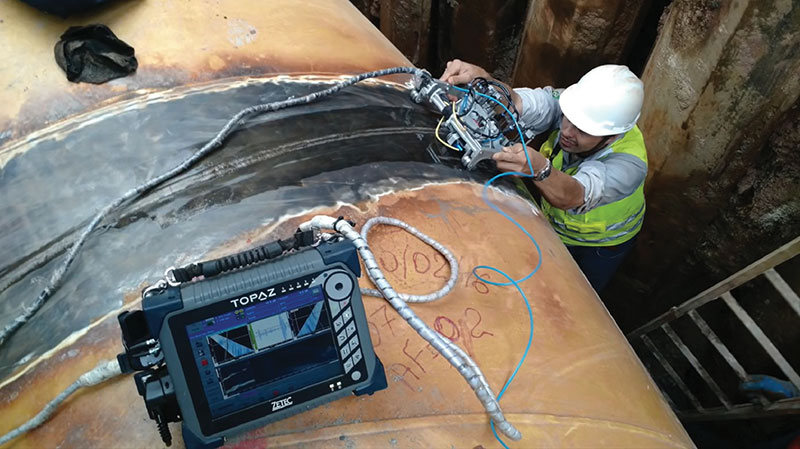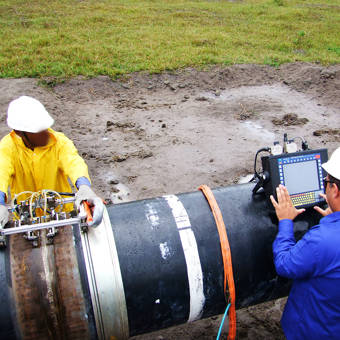Optimize Performance: Proactive Pipeline Welding Inspection Approaches
Optimize Performance: Proactive Pipeline Welding Inspection Approaches
Blog Article
Comprehensive Summary of Pipeline Welding Assessment Procedures
In the realm of pipeline building and construction, making sure the integrity and security of bonded joints is vital. Pipeline welding examination treatments play a crucial duty in assuring that bonded links fulfill strict industry criteria and requirements. From thorough pre-welding inspections to extensive post-weld evaluations, a well-defined evaluation process is important for maintaining the structural stability of pipelines. Understanding the intricacies of welding evaluation procedures is not only a regulative need but likewise a basic aspect of maintaining the dependability of these crucial infrastructures.
Pre-welding Examination Preparations
Prior to starting the welding procedure, detailed pre-welding examination prep work are necessary to make sure the stability and quality of the weld joint. These preparations entail a careful evaluation of the materials to be welded, the welding tools, and the job atmosphere. By carrying out detailed pre-welding examination prep work, possible problems can be determined and solved early on, leading to top quality and dependable weld joints.
Welding Treatment Qualification
Thorough pre-welding examination prep work lay the structure for the vital procedure of Welding Procedure Credentials, making sure the integrity and high quality of the weld joint. Welding Treatment Certification (WPQ) is an essential action in the welding procedure that involves screening and certifying welding procedures to assure they satisfy specific requirements and requirements. The WPQ procedure normally includes welding treatment spec development, welding procedure credentials testing, and paperwork of the outcomes.
Throughout welding procedure spec development, vital information such as the welding process, welding materials, joint style, and welding specifications are specified to produce an extensive procedure. Ultimately, welding procedure qualification testing is performed to confirm the proposed procedure's stability. This screening usually involves welding test vouchers that undergo various mechanical and non-destructive examinations to examine the weld's top quality and adherence to the specified criteria.
In-process Weld Inspection
Throughout the welding process, in-process weld evaluation plays a critical role in making sure the top quality and honesty of the weld joint - Pipeline Welding Inspection. This kind of assessment entails monitoring the welding parameters, examining the weld grain development, and finding any type of potential problems or discontinuities as they happen. By carrying out in-process weld examinations, welding drivers can immediately resolve any kind of concerns that may emerge, consequently making certain and protecting against additional problems that the final weld fulfills my response the needed specs
Usual approaches utilized for in-process weld examination consist of aesthetic inspection, fluid penetrant screening, magnetic particle screening, ultrasonic screening, and radiographic testing. Generally, in-process weld inspection is necessary for maintaining the high quality and dependability of welded pipelines.
Non-destructive Screening (NDT)
Non-destructive Testing (NDT) is a vital approach utilized in pipe welding assessment to examine the stability of weld joints without creating damages to the bonded framework. By using numerous NDT methods, examiners can evaluate the high quality of welds and recognize any kind of problems or interruptions that might compromise the structural strength of the pipe. Usual NDT approaches used in pipeline welding evaluation consist of Radiographic Testing (RT), Ultrasonic Testing (UT), Magnetic Bit Checking (MPT), Fluid Penetrant Screening (LPT), and Visual Screening (VT)
RT entails the usage of X-rays or gamma rays to generate photos of the interior structure of the weld, permitting assessors to discover flaws such as porosity, cracks, or incomplete fusion. In addition, VT includes visual inspection of welds to recognize any type of visible flaws.
Post-weld Evaluation and Documents


Documentation of post-weld inspection findings is essential for keeping top quality control records and guaranteeing conformity with market standards and regulations. Thorough reports should consist of information concerning the inspection approaches made use of, the place and nature of any issues discovered, and any restorative actions taken - Pipeline Welding Inspection. Appropriate documents not only acts as a document of the weld's quality however additionally help in future maintenance and evaluation procedures
Conclusion

In verdict, pipeline welding examination procedures play a vital role in making certain the quality and stability of welds. From pre-welding inspections to post-weld paperwork, each action is important in preserving the safety and effectiveness of pipes. By complying with established treatments and performing extensive inspections, prospective defects can be determined and dealt with before they result in costly repair work or failings. In general, adherence to proper assessment methods is essential to the success of pipeline welding jobs.
From thorough pre-welding examinations to comprehensive post-weld assessments, a well-defined inspection process is important for preserving the structural sturdiness of pipes. By conducting in-process weld inspections, welding operators can immediately attend to any kind of problems that may develop, consequently guaranteeing and avoiding further defects that the last weld satisfies the needed specifications.
Usual approaches made use of for in-process weld examination include visual examination, fluid penetrant testing, magnetic particle screening, ultrasonic testing, and radiographic testing.Non-destructive Screening (NDT) is a critical approach employed in pipe welding assessment my response to evaluate the honesty of weld joints without triggering damages to the bonded structure. Post-weld assessment involves numerous techniques to assess the welds for flaws, including aesthetic assessment, dye penetrant screening, magnetic bit testing, ultrasonic testing, and radiographic testing.
Report this page